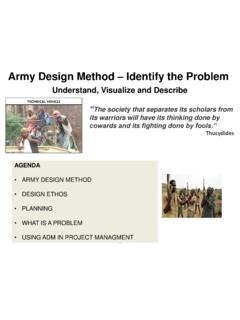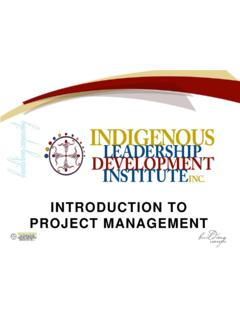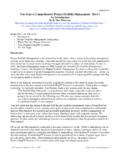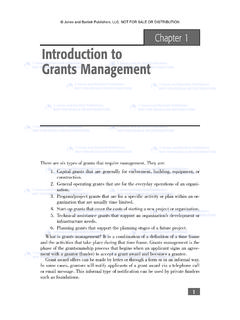Transcription of 1 ITIL Service Lifecycles and the Project Manager
1 1. ITIL Service Lifecycles and the Project Manager The intersection of IT. Service and Project Delivery Presented to: Kansas City Mid-America PMI. Chapter Mark Thomas 1. January 17, 2011. 2. Agenda Introduction What's Out There? IT Infrastructure Library (ITIL). Project Management Putting Them Together Closing and Questions 2. 3. Introduction Synopsis ITIL and PM: Two points of view with one goal. There is often much confusion today regarding how and when Project Management principles align with the various Service Lifecycles of the ITIL Framework. The answer is not always easy. ITIL focuses on providing IT services with respect to customer expectations, while PM drives and delivers projects that delivers a product or Service for that customer. Often times, the failure to use these differences to our advantage results in overall Service failure.
2 Although these two disciplines have their differences, with closer inspection, they have many more inputs, outputs and dependencies that meets the eye. In this one hour presentation, we will explore the essentials of how these two often separately managed frameworks can leverage each other to produce the results asked for by their customers. Two points of view with one goal. 3. 4. Introduction Learning Objectives The intent of this presentation is to discover the many synergies and intersections of the ITIL Service lifecycle Phases and Project Management. Our learning objectives include: Understand the basic elements of the IT Infrastructure Library (ITIL) and the Service lifecycle phases. Review foundational aspects of Project Management based on the Project Management Body of Knowledge (PMBOK). Understand the similarities, differences, and intersections of these two disciplines and how they both lead towards the same goal.
3 4. 5. Agenda Introduction What's Out There? IT Infrastructure Library (ITIL). Project Management Putting Them Together Closing and Questions 5. 6. What's out there? Models, Frameworks, Standards, and Best Practices There are multiple models, frameworks, standards, and best practices to chose from when considering governance initiatives. A short list of these include: Service Management: IT Infrastructure Library (ITIL), Microsoft Operations Framework (MOF). International Standards Organization (ISO): 20000, 27000, 38500. IT Controls and Alignment: Control Objectives for Information and Related Technology (COBIT), VAL IT. Project Management: Project Management Body of Knowledge (PMBOK), Projects in Controlled Environments (PRINCE2), Agile Others: Business Analysis Body of Knowledge (BABOK), Business Process Management Common Body of Knowledge (BPM CBOK), Software Engineering Body of Knowledge (SWEBOK), The Open Group Architecture Framework (TOGAF), Six Sigma, etc.
4 6. 7. Agenda Introduction What's Out There? IT Infrastructure Library (ITIL). Project Management Putting Them Together Closing and Questions 7. 8. IT Infrastructure Library (ITIL). What is ITIL? ITIL is the most widely accepted approach to IT Service management in the world. Providing a cohesive set of best practice guidance drawn from the public and private sectors across the world. ITIL is guidance developed by the United Kingdom's Office of Government Commerce (OGC) and has become a world- wide de facto standard in Service Management. The Guidance, documented in a set of five books, describes an integrated, process based, best practice framework for managing IT services . Currently these books are the only comprehensive, non- proprietary, publicly available guidance for IT Service Management. 8. 9. IT Infrastructure Library (ITIL).
5 services , Processes, Roles, and Functions The ITIL Framework focuses on the following key areas to assist in proper management of the Service lifecycle : Reference: ITIL V3. 9. 10. IT Infrastructure Library (ITIL). IT services Service management is a set of specialized organizational capabilities for providing value to customers in the form of services . A Service is a means of delivering value to customers by facilitating outcomes customers want to achieve without the ownership of specific costs and risks. From a customer's perspective, value consists of two primary elements: utility (fit for purpose), and warranty (fit for use). services are part of the IT Service Portfolio, and are communicated to customers via the Service Catalog. Reference: ITIL V3 Service Strategy Publication 10. 11. IT Infrastructure Library (ITIL). lifecycle Phases The ITIL framework is focused on the lifecycle of an IT Service .
6 There are five phases of this lifecycle . Continual Service Service Service Service Service Strategy Design Transition Operation Improvement As a point of Provides guidance Describes the This is where Aligning and origin for the on the design of delivery of services are realigning IT. phases, Service IT services , services required actually delivered services to Strategy provides processes and by a business into and supported in changing business guidance on other aspects of live or the in the needs by clarifying and the effort by operational use, business identifying and prioritizing addressing how a and often environment implementing investments in planned Service encompasses based on Service services . solution interacts many Project previously improvements with the business delivery aspects. designed Service that support and technical levels.
7 Business environments. processes. Reference: ITIL V3. 11. 12. IT Infrastructure Library (ITIL). Processes Each phase of the lifecycle has processes defined that support each phase. Below is a sample of these processes: Reference: ITIL V3. 12. 13. Agenda Introduction What's Out There? IT Infrastructure Library (ITIL). Project Management Putting Them Together Closing and Questions 13. 14. Project Management Definitions A Guide to the Project Management Body of Knowledge (PMBOK). is a recognized standard for the Project management profession that has evolved from the recognized good practices of Project management practitioners who contributed to the standard. A Project is a temporary endeavor undertaken to create a unique product, Service , or result. Project management is the application of knowledge, skills, tools, and techniques to Project activities to meet the Project requirements.
8 Reference: A Guide to the Project Management Body of Knowledge, Fourth Edition 14. 15. Project Management Knowledge Areas Project Integration Project Scope Project Time Management Management Management Develop Project Charter Collect Requirements Define Activities Develop Project Management Plan Define Scope Sequence Activities Direct and Manage Project Execution Create WBS Estimate Activity Resources Monitor and Control Project Work Verify Scope Estimate Activity Durations Perform Integrated Change Control Control Scope Develop Schedule Close Project or Phase Control Schedule Project Cost Project Quality Project Human Resource Management Management Management Estimate Costs Plan Quality Develop Human Resource Plan Determine Budget Perform Quality Assurance Acquire Project Team Control Costs Perform Quality Control Develop Project Team Manage Project Team Project Communications Project Risk Project Procurement
9 Management Management Management Identify Stakeholders Plan Risk Management Plan Procurements Plan Communications Identify Risks Conduct Procurements Distribute Information Perform Qualitative Risk Analysis Administer Procurements Manage Stakeholder Expectations Perform Quantitative Risk Analysis Close Procurements Report Performance Plan Risk Responses Monitor and Control Risks Reference: A Guide to the Project Management Body of Knowledge, Fourth Edition 15. 16. Project Management Process Groups Project management processes are grouped in to five categories known as Project Management Process Groups. These process groups are not phases Processes Processes required Processes Processes required Processes performed to to establish the performed to to track, review, performed to define a new scope of the complete the work and regulate the finalize all Project or a new Project , refine the defined in the progress and activities across all phase oaf an objectives, and Project performance of Process Groups to existing Project by define the course management plan the Project ; formally close the obtaining of action required to satisfy the identify any areas Project or phase.
10 Authorization to to attain the Project in which changes start the Project or objectives that specifications. to the plan are phase. the4 Project was required; and undertaken to initiate the achieve. corresponding changes. Reference: A Guide to the Project Management Body of Knowledge, Fourth Edition 16. 17. Agenda Introduction What's Out There? IT Infrastructure Library (ITIL). Project Management Putting Them Together Closing and Questions 17. 18. Putting them Together ITIL and PMBOK Similarities services are all of the things we do to deliver value to our customers. In effect services are a type of product. Projects are temporary endeavors to accomplish specific outputs. So we can look at projects as one mechanism or vehicle for establishing and delivering services and products. Both aim to provide reference guidance, common language, and descriptive vs.








